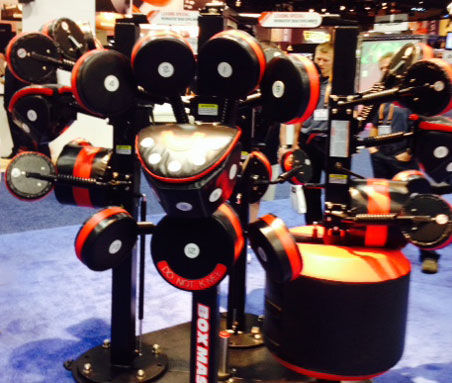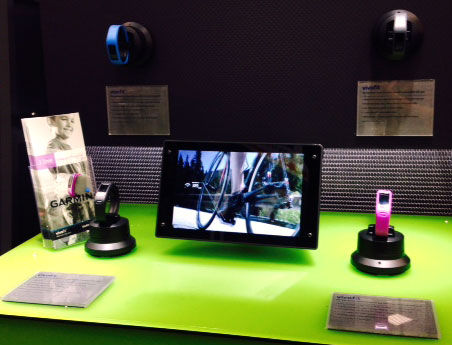With the recent proliferation of low-cost gyms, CrossFit boxes and specialty studios, combined with the expansion of established health-club companies, the fitness industry appears to be in a period of significant growth. This was evident by the size of this year's trade show at the annual International Health and Racquet Sportsclub Association (IHRSA) conference. As more consumers invest in health-club memberships, attend classes at private studios or sweat buckets during a grueling WOD, a number of established fitness companies are expanding their product lines to meet the surging demand.
There are certainly some products that make you shake your head and ask, “Why?” Others, however, are spot on in creating a new category or meeting a need. These are the ones that have you shaking your head and asking, “Why didn't I invent that?”
The most noticeable trend at this year’s show was products and services intended to provide more interaction or touch points with the fitness consumer. Group fitness video on demand and a large quantity of biometric data-capture devices suggest that companies are looking to provide solutions to help people increase physical activity, both in and out of the gym setting. Other products featured ways to provide unique and engaging workouts for club goers.
When I look at a new product, I try to determine whether or not it might have sticking power. The “stickiness” of a new product depends on how intuitive it is to use and, more importantly, whether or not it is both safe and effective.
As I do at every IHRSA trade show, I tried to hit as many of the booths as possible and the following list includes what I think will be emerging trends in the coming years. The folks at Trigger Point, for example, have combined the benefits of self-myofascial release with the anti-inflammatory response of cold treatment to create a roller that can relieve muscle tension while reducing inflammation.
When we shot this BOSU video in late 2012, David Weck was still developing his concept of Rotational Movement Training, which uses rhythmic and circular movements to strengthen fascial structures to improve performance. The Weck Method features the use of a newly re-designed BOSU balance trainer, which has a different surface for better grip and includes a series of numbers that represent specific reference points for feet and hand placement. The Weck Method also features a modern version of the Indian club that is extremely useful for enhancing strength of the hands, forearms, shoulders and hips.
The Boxmaster by Star Trac

Once upon a time I used to teach two to three boxing-conditioning classes a week. While the most enjoyable part of the class for participants is hitting stuff, the hardest part for the instructor is being the target that is getting hit. Focus mitts are a great tool, but can be a challenge to use with all class participants. The Star Trac Boxmaster is a treadmill for focus mitts; the pads are numbered so a trainer can call out specific combinations making it a reactive-based exercise. If not hit properly it’s easy to hurt a wrist using a heavy bag, but the pads of the Boxmaster are angled so that the wrist and shoulder align. This creates more stability in the joints, as well as increases the power transmitted to the target.
Admittedly, when I first saw this product I didn’t really get it, but after playing with it for a bit I like it a lot. Rope training requires grip strength, eye-hand coordination and muscular endurance and/or power. The dynamic resistance of the rope trainer is like doing speed, agility and quickness drills for your hands. The cool thing is the way the resistance is applied—the faster you move the rope, the greater the resistance, which can be humbling.
Quantified Self Biometric Data Measuring Devices

This is the technology that will finally create the merger of the fitness and medical industries. It was a major theme of this year's trade show, with many companies selling data-measuring devices and most equipment manufacturers showing how they’re designing cardio equipment that allow users to track workouts on smartphone apps. Biometric data-capture devices allow individuals to monitor the amount of work they’re doing when they exercise and simply moving throughout the day. Some even go so far as to monitor you while you’re sleeping to help you determine how to sleep more effectively, which is important because sleep is the time when your body tissues regenerate and become stronger as a result of exercise. Former ACE board member and consultant Ted Vickey has been working in this space and wrote an excellent blog on various products and how they can be used with clients.
Video on Demand Group Fitness Classes
For smaller, independent clubs, franchises, corporate fitness centers and hotel workout rooms that don't have the capital to invest in a group fitness program, video on demand makes sense. However, I’m not a fan of this concept for larger clubs with an established group fitness program. Clubs that operate successful group fitness programs, like Equinox, know that group fitness instructors are among a club’s best member-retention tools. A good instructor engages ALL students and creates a personal connection with participants that keeps them coming back. Video classes may be a cost-effective way to provide programming, but it lack the power created by human-to-human contact.
This is by no means a comprehensive list, but these are some products that can easily meet my litmus test of being a “sticky” fitness product—easy to use and based in real science—and are ones that you should keep an eye out for in the coming months and years.




 by
by 








 by
by